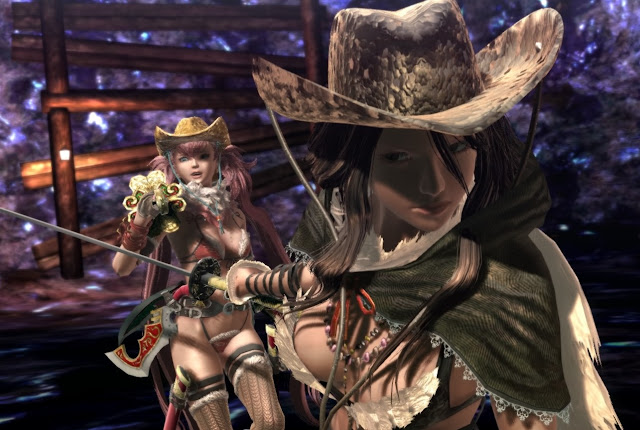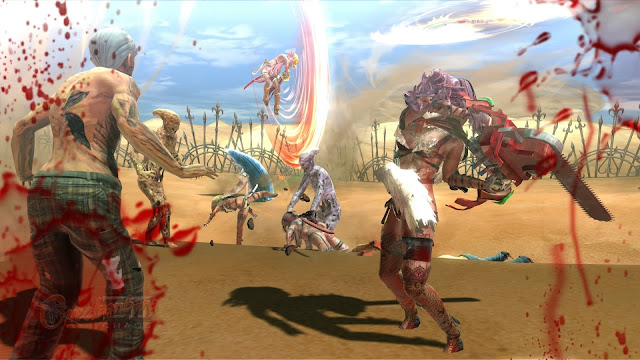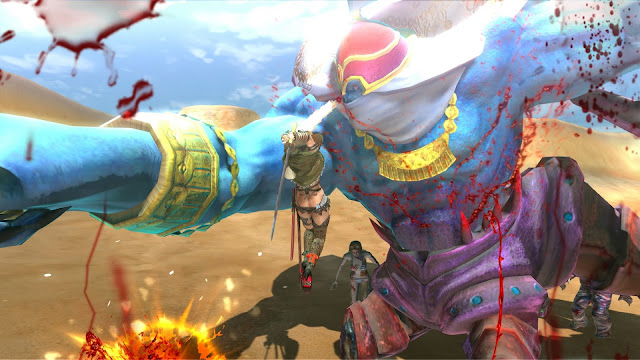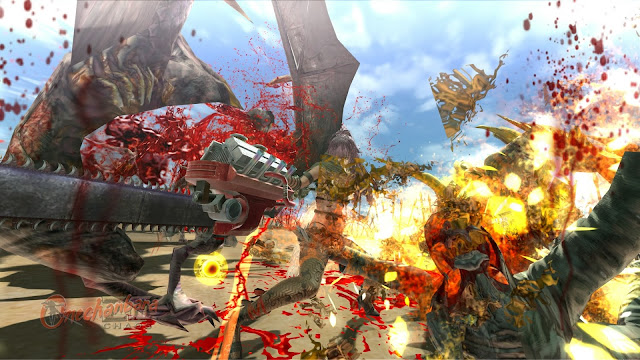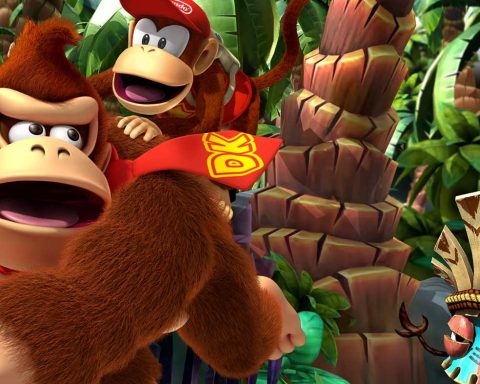It amuses me to know that this game will almost certainly be fixated on by a large number of critics and players for its costuming. They won’t be entirely wrong for that, because the four protagonists of Onechanbara Z2: Chaos really are dressed in the most ridiculously skimpy costumes from the outset, and the unlockable alternate costumes only take things even further.
So I can certainly appreciate why people might see sexualisation when they play Onechanbara. But what amuses me about all this is that those same people won’t bother pointing out how gratuitous and excessive the violence is. The streams of gore that splash around the screen with every button press is every bit as excessive as the costuming, but as we all know by now, in the west promising gore elicits cheers (as we saw in the way people responded to the Doom reveal at E3 this year), but the slightest hint of exposed flesh and the pundits get a-typing.
Not that I have an issue with the violence either. My issue is just the explicit hypocrisy in attacking this game over its costumes but ignoring the violence. But anyway I digress, because I’m not meant to be here to write yet another piece on how ridiculous the double standards are between the way we treat adult violence and adult sexuality in our media. I’m here to review Onechanbara. And it is one very fine piece of exploitation entertainment indeed.
For those who aren’t old people like me and haven’t grown up with it, exploitation was a very popular film genre back in the 70s and 80s, with all kinds of sub-genres such as cannibal films, grindhouse, slasher, ozploitation and so on being churned out at an incredible rate. These films were made cheaply, had B-grade production values, and would be utterly ignored by the audience were it not for the two draw cards that will always pull in an audience – sex, and gore.
These cheap thrill films were what many of the great artists of today grew up watching. Quentin Tarantino, for example, is a infamous fan of various exploitation film genres, and through his career did a good job time and time again of taking the core elements of exploitation films and reworking them to turn them into his own brand of avant-garde masterpieces. Sam Raimi, Peter Jackson, Eli Roth, and too many other great filmmakers to mention here all started out working in exploitation films, while almost any favourite actor you can mention got his or her break performing in one early in their careers.
For anyone able to move past the obvious (and entirely legitimate) issues that the exploitation genre raises around various fields of social philosophy (feminism being the most obvious example), it is a genre that isn’t necessarily intellectually engaging (though should you ever study film at university you’ll also discover that they’re by no means as “stupid” as most people attribute to them), but it is certainly a whole lot of fun. Especially after a couple of beers. These films are typically so crass, so over-the-top, and so surreal that it’s hard not to have a good time watching them. Contrary to popular belief they are not “so bad they’re good.” That phrase is a misnomer. Rather, the best examples of these B-films are quite deliberately and carefully constructed in order to prove a very specific reaction from the audience. That is why we remember I Spit On Your Grave, Friday the 13th, and Dawn of the Dead, but almost no one remembers something like Blood Cult. The former were better made films than most people give them credit for. The later was not.
Onechanbara Z2: Chaos comes to us from a culture that still has a deep love of B-movie exploitation tradition. Many, many Japanese filmmakers are still deeply influenced and entertained by exploitation, and some of the modern Japanese cult classics, such as Tokyo Tribe and Hentai Kamen, are twists on the base structures of exploitation. Coming from that artistic culture, it is perhaps not surprising that Onechanbara is itself is a very fine example of everything the genre stands for. Again, I don’t mean this in a so-bad-it’s-good sense, because it’s not bad at all. It’s actually very well made. Underneath the extreme, unrelenting gore and bikinis (hyuck, underneath the bikinis, hyuck) is a incredibly fast and furious action game that is an absolute feast for the eyes. In fact, I’ve stretched my mind back as far as I can and I cannot think of a single game that I have played that is faster or a greater overload of the visual senses than this one.
In very broad terms the game’s combat system works like you’d see in a Warriors game or similar. Each of the four protagonists behaves differently in terms of attack speed and the weapons they use, but each has a weak attack, a strong attack, and by fighting a lot of enemies they can also build up super attacks. They’ll run through quite linear environments before rushing into a room that spawns a whole load of enemies, which they’ll need to defeat before moving on.
Where the game deviates from the aforementioned Warriors series is that Onechanbara Z2: Chaos is fast. Like really, really fast. Aside from the boss battles (where there’s attack patterns that you’ll need to learn so you can dodge out of the way), offense is the best and, really, only form of defense, with the best way to deal with the enemies is to wade into the thick of them and start whaling away. There’s a jump button that, when held down, causes the character to dash into the air, taking all the enemies around her with her, and I found excess use of that more effective than the dodge button in most situations anyway, as it tended to get me out of danger while also doing a load of damage to a horde of enemies at the same time.
So fast is the combat of Onechanbara that, coupled with the bloodletting, I would frequently lose sight of my character. This would sound like a problem, but the game is quite generous on the health bars of characters, even on the higher difficulties, and I found that by simply staying mobile I was able to stay out of the way of taking too much harm from the brain-dead (pardon the pun) enemies anyway. Most monsters are some form of undead or demonic beastie, and they behave about as intelligently, making tactics less important overall than simply sticking a chainsaw in the face of whatever is closest.
But again, it’s not a complaint, because Onechanbara executes everything with such furious energy and flash that it’s a lot of fun. Each character actually has a deep combo list and range of unlockable weapons, items, and skills, which is enough to keep you playing through its relatively short (four hours) run time. Part of the long term value in this game is earning the unlockables and playing dress-up… or dress-down as the case might be, but I actually applaud the developer for keeping the experience relatively brief, as it clearly knows not to not outstay its welcome.
And, while the game is clearly a budget production and has the odd strange camera angle that makes things tough, it is still a Tamsoft game, and this developer knows how to produce action titles. Even when I lost my character behind a horde of shredded zombies and crimson, or had the camera spin out on me, never was I left feeling frustrated, like the engine was treating me badly. There’s a subtle difference, but when there is a technical bug or instance of poor design in Onechanbara, it’s fleeting and never critical. A less experienced studio under the same circumstances would pummel your character to the Game Over screen.
In terms of aesthetics the range of environments on offer are good, albeit simple in construction, and the enemies, though limited in variety, make up for it with the size of the hordes and some impressive boss battles. The narrative is what you might expect for a work of exploitation horror – it’s terrible stuff – but it’s enough to at least give context to the game and, indeed, position it as exploitation horror rather than aspiring to be something more.
As myself someone who grew up watching exploitation films, studied them at university, and have generally remained a fan of the kitsch aesthetic, Onechanbara Z2: Chaos is a resounding success as both an example of the genre and a homage to everything that makes it fun. That kitsch style is quite clearly the only thing Tamsoft wanted to achieve in this project, and weighed against that target, it absolutely hits the bullseye. This is a B-grade game in every sense of the word, but it is so ridiculously good, gory, chesty fun that I was truly mesmerised from start through finish.
– Matt S.
Editor-in-Chief
Find me on Twitter: @digitallydownld

